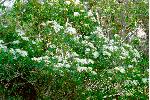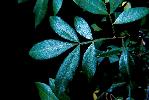Species profile—Cossinia australiana
Classification
Plantae (plants) → Equisetopsida (land plants) → Sapindaceae → Cossinia australiana

Go to Photo gallery
Sighting data
Species details
- Kingdom
- Plantae (plants)
- Class
- Equisetopsida (land plants)
- Family
- Sapindaceae
- Scientific name
- Cossinia australiana S.T.Reynolds
- WildNet taxon ID
- 13684
- Alternate name(s)
- cossinia
- Nature Conservation Act 1992 (NCA) status
- Endangered
- Environment Protection and Biodiversity Conservation Act 1999 (EPBC) status
- Endangered
- Conservation significant
- Yes
- Confidential
- No
- Endemicity
- Native
- Pest status
- Nil
- Short Notes
- BRI 299153, handwriting of author
- Description
- Cossinia australiana is shrub or small slender tree that grows to 7 m in height and 10 cm DBH, with a sparse crown and few branches. The leaves are compound, usually with a winged rhachis and there are 3 to 5, (occasionally 7), elliptical to oblong leaflets that are opposite. The undersurface of the leaflets and the young growth is densely hairy. The petiole is 1.2 to 4.3 cm long. The leaflet stalks are about 2 mm long. The leaflet blades are 2 to 7.5 cm long by 0.9 to 2.8 cm wide and are widest in the middle. The leaflets vary in size with the top leaflet being the largest. The flowers grow in clusters to 2.5 cm long and wide. Each flower has a 5-lobed calyx, five petals and are on a stalk 2 to 4 mm long. The calyx lobes are broadly ovate to oblong and 3 to 4.5 mm long by 1 to 1.5mm wide and are hairy. The petals are also broadly ovate-oblong and 3 to 4.5 mm long by 1 to 1.5 to 3 mm wide and are hairy outside. The fruit is a capsule 1.5 to 1.8 cm long by 1.2 to 1.6 cm wide and is hairy. The fruit has a stalk 7 mm long (Reynolds, 1982).
There are no other species of Cossinia in Australia. - Map
- View Map
- Distribution
- Cossinia australiana is known from fragmented remnant patches of Araucarian vineforests or vine thickets on fertile soils in central and southern Queensland. The species' distribution is from Rockhampton to Kingaroy, east of the Great Dividing Range, a distance of approximately 300 km. At most sites it is recorded as uncommon, usually as scattered individuals (DSEWPC, 2012; Queensland Herbarium, 2012). C. australiana occurs in Bouldercombe Gorge Resources Reserve, Cania Gorge National Park and Reedy Creek Nature Refuge. The species also occurs in Brooyar, Coominglah, Grevillea, Kalpowar and Montour State Forest and Callide Timber Reserve (Queensland Herbarium, 2012).
- Distributional limits
- -23.1067562, 150.4094155
-26.5255556, 152.6721661 - Range derivation
- Range derived from extent of the taxon's verified records
- Habitat
- Cossinia australiana occurs from 20 to 520 m altitude. The species appears to prefer ecotonal situations around dry rainforest edges, although it also occurs as scattered individual plants within closed forest communities. It grows in araucarian microphyll vine forest and relict semi-evergreen vine thicket on a variety of soils, including red volcanic soil and black loam. Trees and shrubs which C. australiana is often associated include Alyxia ruscifolia (chain fruit), Capparis arborea (brush caper berry), Drypetes deplanchei (yellow tulip), Flindersia australis (crow's ash), Owenia venosa (crow's apple) and Siphonodon australis (ivory- wood). Associated vine species include Cissus oblonga, Malaisia scandens and Melodorum leichhardtii (Borsboom and Wang, 1997; Queensland Herbarium, 2012).
- Reproduction
- Flowering has been recorded from October to January, with fruiting recorded in February. The tree readily suckers from the roots up to 5 m from the main trunk (Borsboom and Wang, 1997).
- Threatening processes
- The main identified threat to Cossinia australiana is exotic weeds, including Lantana (Lantana camara), Dutchman's Pipe (Aristolochia elegans), Madeira Vine (Anredera cordifolia), Cat's Claw Creeper (Macfadyena unguis-cati) and Climbing Asparagus (Asparagus plumosus) (Barry and Thomas, 1994; Borsboom and Wang, 1998; DSEWPC, 2012; Queensland Herbarium, 2012). Invasion of vine forest margins by weeds also increases fuel loads and leads to fire incursions (Barry and Thomas, 1994; Borsboom and Wang, 1998).
The main potential threats to the species include habitat loss due to clearing, increased disease and susceptibility to insects due to the very small isolated populations and fragmented habitat (Barry and Thomas, 1994; Borsboom and Wang, 1998). Two populations are confined to roadside remnants and are therefore threatened by road widening and maintenance activities. One population occurs on a coal mining lease (DERM, 2010; DSEWPC, 2012; Queensland Herbarium, 2012). - Status notes
- Cossinia australiana is listed as Endangered under the Queensland Nature Conservation Act 1992 and Endangered under the Commonwealth Environment Protection and Biodiversity Conservation Act 1999
- Management recommendations
- Regional and local priority actions to support the recovery of Cossinia australiana are outlined by DSEWPC (2012). A summary of these include: avoiding habitat loss, disturbance and modification (e.g. monitor known populations to identify key threats; monitor the progress of recovery, including the effectiveness of management actions and the need to adapt them if necessary; identify populations of high conservation priority); controlling invasive weeds (e.g. identify and remove weeds in the local area, which could become a threat to Cossinia, using appropriate methods; manage sites to prevent introduction of invasive weeds, which could become a threat to Cossinia, using appropriate methods; develop and implement a management plan for the control of invasive weeds, especially lantana, Dutchman's pipe, Madeira vine, cat's claw creeper and climbing asparagus in the region); increasing conservation information (raise awareness of Cossinia australiana in the local community); and enabling recovery of additional sites and/or populations (DSEWPC, 2012).
- Notes
- Occurs in the following Queensland pastoral districts: Burnett, Port Curtis, Wide Bay.
- References
- Barry, S.J. and Thomas, G.T. (1994). Threatened Vascular Rainforest Plants of South-east Queensland: A Conservation Review. QDEH: unpublished Report to ANCA.
Borsboom, A. and Wang, J. (1997). Species Management Profile for Cossinia australiana, Resource Sciences Centre, Department of Natural Resources (DNR).
Department of Sustainability, Environment, Water, Population and Communities (DSEWPC) (2012). Cossinia australiana in Species Profile and Threats Database, Department of Sustainability, Environment, Water, Population and Communities, Canberra. Accessed 25/06/2012. http://www.environment.gov.au/sprat.
Queensland Department of Environment and Resource Management (DERM) (2010). Burnett Mary Natural Resource Management Region Back on Track Actions for Biodiversity. Department of Environment and Resource Management, Brisbane.
Queensland Herbarium (2012). Specimen label information. Queensland Herbarium. Accessed 19/01/2012.
Reynolds, S.T. (1982). Notes on Sapindaceae in Australia, II. Austrobaileya 1 (5): 486, fig. 38.
Reynolds, S.T. (1984). in Stanley, T.D. and Ross, E.M. Flora of South-eastern Queensland 1: 504. - Profile author
- Ronald Booth (25/06/2012)
Other resources
- Species Profile and Threats Database (SPRAT)
- The Australasian Virtual Herbarium (AVH)
- Atlas of Living Australia
Data source
This profile data is sourced from the QLD Wildlife Data API using the Get species by ID function used under CC-By 4.0.
https://apps.des.qld.gov.au/species/?op=getspeciesbyid&taxonid=13684.
This information is sourced from the WildNet database managed by the Queensland Department of Environment and Science.



